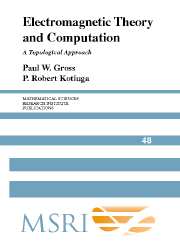Book contents
- Frontmatter
- Table of Contents
- Preface
- Introduction
- 1 From Vector Calculus to Algebraic Topology
- 2 Quasistatic Electromagnetic Fields
- 3 Duality Theorems for Manifolds With Boundary
- 4 The Finite Element Method and Data Structures
- 5 Computing Eddy Currents on Thin Conductors with Scalar Potentials
- 6 An Algorithm to Make Cuts for Magnetic Scalar Potentials
- 7 A Paradigm Problem
- Mathematical Appendix: Manifolds, Differential Forms, Cohomology, Riemannian Structures
- Bibliography
- Summary of Notation
- Examples and Tables
- Index
6 - An Algorithm to Make Cuts for Magnetic Scalar Potentials
Published online by Cambridge University Press: 06 July 2010
- Frontmatter
- Table of Contents
- Preface
- Introduction
- 1 From Vector Calculus to Algebraic Topology
- 2 Quasistatic Electromagnetic Fields
- 3 Duality Theorems for Manifolds With Boundary
- 4 The Finite Element Method and Data Structures
- 5 Computing Eddy Currents on Thin Conductors with Scalar Potentials
- 6 An Algorithm to Make Cuts for Magnetic Scalar Potentials
- 7 A Paradigm Problem
- Mathematical Appendix: Manifolds, Differential Forms, Cohomology, Riemannian Structures
- Bibliography
- Summary of Notation
- Examples and Tables
- Index
Summary
6A. Introduction and Outline
In this chapter we consider a general finite element-based algorithm to make cuts for magnetic scalar potentials and investigate how the topological complexity of the three-dimensional region, which constitutes the domain of computation, affects the computational complexity of the algorithm. The algorithm is based on standard finite element theory with an added computation required to deal with topological constraints brought on by a scalar potential in a multiply connected region. The process of assembling the finite element matrices is also modified in the sense described at length in the previous chapter.
Regardless of the topology of the region, an algorithm can be implemented with 𝒪 (m30) time complexity and 𝒪 (m20) storage where m0 denotes the number of vertices in the finite element discretization. However, in practice this is not useful since for large meshes the cost of finding cuts would become the dominant factor in the magnetic field computation. In order to make cuts worthwhile for problems such as nonlinear or time-varying magnetostatics, or in cases of complicated topology such as braided, knotted, or linked conductor configurations, an implementation of 𝒪 (m20) time complexity and 𝒪 (m0) storage is regarded as ideal. The obstruction to ideal complexity is related to the structure of the fundamental group This chapter describes an algorithm that can be implemented with 𝒪 (m20) time complexity and 𝒪 (m4/3 0 ) storage complexity given no more topological data than that contained in the finite element connection matrix.
Information
- Type
- Chapter
- Information
- Electromagnetic Theory and ComputationA Topological Approach, pp. 159 - 182Publisher: Cambridge University PressPrint publication year: 2004
